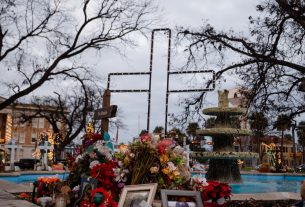|
Getting your Trinity Audio player ready...
|
The water rushed into the warship in darkness. As the Thai naval ship rocked in the rough waters and began to tilt, the 105 sailors on board scrambled for life jackets, knowing they were 30 short.
They tried to maintain control of the ship, the HTMS Sukhothai, but water short-circuited the power system. The engine died. The rudder locked. The pumps, which remove water from the ship, failed.
More than 20 miles from the nearest coast, the sailors called for help. Other ships approached, but were unable to get close enough to assist because of the choppy seas.
When the 35-year-old warship rolled onto its side, some sailors called their families. The 30 people without life jackets grabbed buoys or tried to escape on inflatable rafts.
Three hours after it started taking in water, the ship sank on Sunday around 11:30 p.m. Five days later, 23 of the crew remain missing, while 76 have been found. Six bodies have been recovered.
Although the search-and-rescue operation is still underway, the missing men are feared dead. On Friday, one life jacket was found on an island some 70 miles away, bearing the name of a deceased sailor, Jakpong Poonpon. The life jacket would be returned to his family, the authorities said.
Vice Adm. Pichai Lorchusakul, commander of the 1st Naval Area Command, told local reporters that those missing could not be expected to survive in the sea for longer than two days.
As hope of finding survivors dims, scrutiny is now turning to how the accident happened and whether sufficient safety measures were in place.
Choengchai Chomchoengphaet, the commander in chief of the Royal Thai Navy, said on Tuesday that 30 sailors were left without life jackets when the vessel sank, about 22 miles off the coast of Prachuap Khiri Khan Province.
The crew were “fully aware” of the shortage, and when the ship ran into trouble, “they tried to use other tools, which could save the lives of officers who didn’t have life jackets,” he said.
He said that there were extra officers on the ship taking part in a salute to the founder of the Thai navy, and that normally extra life jackets would have been provided.
But he added that “a life jacket does not guarantee survival,” noting that all the sailors had been trained in survival skills.
Thailand’s Meteorological Department had issued a weather advisory for the general area a few hours before the accident, saying waves in the Gulf of Thailand were expected to be 6.5 to 13 feet high. It suggested that all ships “proceed with caution.”
Warren Smith, an associate professor in naval architecture at the Australia Defense Force Academy at the University of New South Wales, said that, generally speaking, warships are built to withstand waves of such heights.
He said that on the Sea State scale — with zero representing total calm and nine meaning phenomenal waves — the conditions at the time would be classified as a five.
The commander in chief of the Royal Thai Navy rejected suggestions that the ship’s age could have contributed to the accident. It had undergone major repairs three years ago, and its equipment was fully functional, he said, adding that there were no plans to retire the ship for another five to 10 years.
The authorities said the ship sank after water flowed into the electrical system through an exhaust pipe, short-circuiting the ship’s controls and water pump system.
Chengi Kuo, a professor of naval architecture at the University of Strathclyde in Scotland, said that usually a ship’s exhaust pipes have a mechanism that prevents water from entering.
Because warships are generally quite small, their engines and power equipment are often packed into a small space, he said, meaning that it is easy for the whole system to go down at once.
When waves are rough, “if you have any structures which are not strong enough, you can have problems and get failures,” Professor Kuo said.
Survivors have recounted to local media how they clung onto the ship as it sank, until they could hold on no more and were swept into the sea. They tried to keep each other afloat as 10- to 13-foot waves crashed over their heads.
Chief Petty Officer Natee Timdee told local media that the waves were “very strong.” “I laid on my back, but then the water hit my face, so I laid with my face down and the water washed on top of my head.”
“I thought about my mother,” he added. “I cannot die, I still have to take care of her.”
Another sailor, crying while talking to a local television station, said: “My heart couldn’t take it anymore, encountering this kind of event. You see people die in front of your eyes like this, and the ones who died are your friends.”
“You went as a full team and returned incomplete,” he added.



